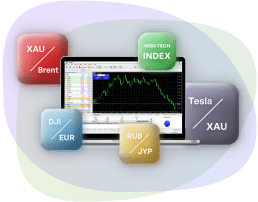Forex Scalping Strategy
Forex Scalping Strategy
Forex Scalping Strategy is based on opening and closing multiple positions on one or more Forex pairs over the course of a day, usually in seconds or minutes during the course of a trend. But before we start, if you are new to Forex trading, it is best to start with the basics, “What is Forex trading and how does it work”.
Traders should always consider the market’s liquidity and volatility before adopting a forex scalping strategy. Using leverage is an important part as well when using a scalping strategy - it helps increase the profits (don't forget about the opposite side of the leverage).

Best scalping strategies lean on use of technical indicators including Bollinger Bands, moving averages, the stochastic oscillator, parabolic SAR and RSI.
KEY TAKEAWAYS
- Forex Scalping is a short-term strategy, the goal is to make profit out of tiny price movements.
- Scalping is also considered a viable strategy for the Forex traders. However, forex scalpers usually need a larger deposit in order to be able to handle the amount of leverage they have to use to make short and small trades to work.
- The best forex scalping strategies involve leveraged trading.
- In Forex trading traders shouldn't risk more than they can afford to lose.
What is Scalping in Forex Trading
Forex Scalping is a short-term strategy, the goal is to make profit out of tiny price movements. The best forex scalping strategies involve leveraged trading. Leverage let's traders borrow capital from a broker in order to gain more exposure to the Forex market, only using a small percentage of the full asset value as a deposit. This strategy increases profits but it can also enhance losses if the market does not move in needed direction. Therefore, forex scalpers are required to keep a constant eye on the market for any changes.
How to Scalp in Forex
1. Create an account with IFC MArkets if you already have it log in to your trading account for CFDs
2. Learn about forex and how to trade it
3. Build a personalized trading plan
4. Then decide whether to go long or short and don’t forget to manage your risks
5. Open and monitor your position
But before it all, there are few things traders needs to know
- Trade The Most Liquid Pairs - EUR/USD, GBP/USD, USD/CHF, and USD/JPY are the most liquid currency pairs so they offer the tightest spreads because they tend to have the highest trading volume. Note: traders need to look for tightest spreads, because they will enter the market quite often.
- Spreads & Transaction Costs - as we mentioned before traders should be thoughtful when choosing brokers, regarding major currency pairs spreads. They have the lowest spreads, so cheapest to trade. As each trade carries transaction costs, scalping can result in more costs than profits.
- News Reports can Confuse Traders - Market volatility is widely affected by news announcements and reports like macroeconomics or GDP data, since traders usually might hurry to make a quick buck - causing chain reaction.
- Trade during the busiest times of the day - these are the most liquid times of the day, during the session overlaps - from 2:00 am to 4:00 am and from 8:00 am to 12:00 noon Eastern Time.
Risk management - Due to the small profits from scalping, traders use larger leverage than usual. Leverage can boost profits, but at the same time it can also lead to significant losses. So if the traders plan on using a higher leverage ratio, proper stop-loss money management is important.
Traders should also pay attention to their risk/reward ratio. This is because traders will often get stopped out in the majority of cases where the gap between their take profit and stop loss levels are narrow.
In Forex trading traders shouldn't risk more than they can afford to lose.
Best Scalping Strategy
As we mentioned, the best scalping strategies lean on the use of technical indicators including Bollinger Bands, Moving Averages, the Stochastic Oscillator, parabolic SAR and RSI.
Bollinger Bands is used to indicate areas of market volatility. Bollinger Bands rely on a simple moving average (SMA) with a standard deviation set above and below to show how volatile a market might be. Traders believe that wider standard deviations indicate increased volatility in and vice versa, if the bands are narrow it might mean that the market is stable.

Bollinger Bands can be divided into two categories of interest to us:
- The Squeeze - When the bands move closer together, limiting the moving average, it is called a squeeze. A squeeze signals a period of low volatility and is seen as a potential sign of future heightened volatility and possible trading opportunities. Conversely, the wider the bands move, the higher the likelihood of a decrease in volatility and the higher the likelihood of exiting a trade.
- Breakouts - Any breakout above or below the bands is a major event.
Moving average (MA) - A moving average is a mathematical formula that helps to spot emerging and common trends in markets, represented as a single line showing an average. The reason for calculating the moving average of a stock is to help smooth out the price data by creating a constantly updated average price.
- Simple moving average (SMA) - s calculated by taking the arithmetic mean of a given set of values over a specified period of time.
Exponential moving average (EMA) - gives more weight to recent prices, making it more responsive to new information. Traders must first calculate (SMA) over a particular time period. Next, have to calculate the multiplier for weighting the EMA which - [2/(selected time period + 1)].
So for example, for a 30 -day moving average, the multiplier would be [2/(30+1)]= 0.0645. Then traders should use the smoothing factor combined with the previous EMA to arrive at the current value.
Stochastic oscillator - is a momentum indicator comparing a particular closing price of a security to a range of its prices over a certain period of time. Indicator is popular for generating overbought and oversold signals.

The Stochastic Oscillator chart usually consists of two lines: one represents the actual value of the oscillator for each session, and the other represents its three-day simple moving average. Since price is believed to be following momentum, the crossing of these two lines is considered a signal that a reversal may be in progress, as it indicates a large shift in momentum from day to day.
The divergence between the Stochastic Oscillator and the trending price action is also seen as an important reversal signal. For example, when a bearish trend makes a new lower low, but the oscillator makes a higher low, it could be an indicator that bearish momentum is running out and a bullish reversal is brewing.
You can see in the chart above.
Parabolic stop and reverse (SAR) - is used to determine the price direction of an asset, as well as draw attention to when the price direction is changing, also known as "stop and reversal system". On the chart appears as dots above or below the market price.

A point below the price is considered a bullish signal, and vice versa - a point above the price is used to illustrate that bearish momentum is in control and that it is likely to remain downtrend. When the dots are swapped, it means that there is a possible change in the direction of the price. For example, if the dots are above the price when they roll over below the price, this could signal a further rise in price.
As the share price rises, the dots will also rise, slowly at first, and then picking up speed and accelerating along with the trend. SAR starts to move a little faster as the trend develops, and soon the points catch up with the price.
Relative strength index (RSI) - is a momentum indicator, uses a range of between zero and 100 to assess whether the market's current direction might be about to reverse. It uses levels of support and resistance – set at 30 and 70 respectively – to identify when the market’s trend might be about to change direction.
When the RSI rises above 70, it probably shows that the market is overbought and a trader may open a short position. If the RSI falls below 30, it probably indicates that the market is oversold and a trader should open a long position.

Scalpers should implement these indicators in their strategies and half of the work is done.
1 Minute Scalping Strategy
Sinse scalpers’ profits are low, they have to open multiple trades and work it to have something resembling profit. Due to the specifics of this kind of trading strategy traders have to open dozens of trades throughout the day and close them in a few seconds or minutes.
1 Minute Scalping Strategy is based on trend-following and mean-reversion which helps to bring to the minimum false signals. Though it doesn't rule out the necessity of proper risk management strategy attached to it.
Volatile market is an integral part of scalping strategy; traders are able to make money because of the price fluctuations. Some traders advise to use the New York-London session overlap; it’s when the market is the most volatile - during those few hours prices are low and liquidity is high.
For this strategy traders will need two moving averages and one oscillator.
- Instruments: any currency pair;
- Time frame: 1 minute;
- Indicators: Stochastic 5, 3, 3 and 50 EMA, 100 EMA;
- Preferred sessions: London, New York - high volatility.
Both moving averages are used to identify the current trend in the 1-minute timeframe. 50 EMA is used to calculate the average price for the past 50 minutes and the 100 EMA for the past 100 minutes. 50 EMA reacts on price movements more quickly than 100 EMA, so it’s faster, both of them give a good understanding of a trend.
- When the 50-period EMA crosses above the 100-period EMA, it means that average prices are starting to rise which is a bullish signal. Similarly, when a cross of the 50-period EMA below the 100-period EMA signals that average prices start to drop and that's a bearish signal.
- Once a short-term trend is defined traders should wait for a pullback to the moving averages. It's important because prices tend to return to their mean value after a strong up- or down-move. Waiting for pullbacks prevents traders from falling into fake signals and losses.
- The last filter Stochastic indicator will help traders to filter only high-probability trades. This indicator varies between 0 and 100 values - depending on the strength of recent price movements. When the value is above 80, it means that the recent up-move was strong and the market is overbought, hence the down-move is expected. And vice versa, when the value is below 20, the market is oversold - up-move is expected to happen.
Pros and Cons of Stock Scalping
Here below you’ll see our take on Pros and Cons of Scalping strategy and may be form your own advantages & disadvantages:
- Pros of Stock Scalping
- Can be very profitable if executed precisely and with a strict exit strategy and proper risk management
- Many opportunities to leverage small changes in the price of a stock
- No need to follow fundamentals
- Very little market risk involved
- Can be used if the market is going up or down
- Can easily be automated within the trading system, like in algo trading strategy
- Cons of Stock Scalping
- High transaction costs (if broker isn’t chosen wisely)
- Requires bigger leverage to make a profit (which can end badly)
- It is time consuming strategy and requires high levels of focus
Bottom Line on Forex Scalping Strategy
As we all know, the Forex market is large and volatile; but we have technical analysis that provides a viable strategy opportunity for trading this market. Scalping is also considered a viable strategy for the Forex traders. However, forex scalpers usually need a larger deposit in order to be able to handle the amount of leverage they have to use to make short and small trades to work.
Scalping requires focus and speed and it's vital if trades want to be successful. So if traders like the action and prefer to focus on one or two minute charts, then scalping is just what the doctor ordered. To sum up; If a trader has high tolerance to losses and a temperament to react quickly then scalping is a good match for him/her.





